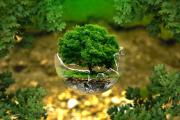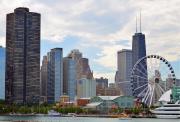Water Saving Tips: CII Water Use
The following are general water saving tips for general operations, cooling, steam, cleaning, sanitary, kitchen, laundry, and landscape water uses in the CII sector.
General Operations:
Conduct a facility audit to quantify water use.
- Understanding water use will indentify savings opportunities, allow appropriate savings targets to be established, and serve as a benchmark from which water savings can be tracked.
- This should be the first step in a water efficiency program. It may be cost-beneficial to hire a professional with expertise in commercial and industrial water use efficiency to carry out an on-site survey.
Compare water use to industry benchmarks if available.
- Water use benchmarks provide an estimation of the average water use for specific industrial sectors and can be used as a tool to evaluate current consumption patterns among peers.
Learn from water saving success stories of industry peers.
- Case studies from industry peers will provide insight into what works, what doesn't, and what efficiency solutions are most cost-effective. These details can often be found in sustainability reports or annual reports.
Investigate the feasibility of the following general options in your operations.
- Reduce the flow of water.
- Modify the equipment or installing water saving devices.
- Replace existing equipment with more water efficient equipment.
- Implementing water treatment, recycling, and reuse practices.
- Change to a waterless process.
Educate employees about the importance of using less water.
- Creating a workplace culture that focuses and takes pride in efficiency can be a very beneficial component of a water conservation plan. Increased awareness will ensure more staff members are monitoring water use.
- Things that can be done include:
- Give recognition to those who initiate water-efficiency procedures and processes.
- Make resource conservation part of performance reviews, especially for line manager.
Use non-potable water for industrial process use.
- Potable water is often not required for many industrial uses and can be substituted with non-potable or reused water. Sources include but are not limited to air conditioner condensate, cooling tower blow down, and rainwater.
Cooling:
Improve cooling tower efficiency.
- Cooling towers often represent the largest percentage of water consumption in industrial operations. Some ways to improve the efficiency of cooling towers and reduce water use include:
- Eliminate once-through cooling.
- Install a conductivity controller on each cooling tower.
- Equip cooling towers with overflow alarms.
- Use high-efficiency drift eliminators.
- Install submeters to monitor make-up and bleed on each cooling tower.
- Properly train and educate cooling tower operators.
Replace water-cooled equipment with air-cooled equipment when feasible.
- Water use is often a hidden component of cooling industrial and commercial equipment. Often this very same equipment is available, but with technology that uses air for cooling. The pros and cons of each should be determined before switching from water to air, considering energy efficiency and equipment performance.
- Equipment that falls into this category include:
- Air compressors
- Vacuum pumps
- Ice machines
- Refrigeration condensers
- Hydraulic equipment
- X-ray processing equipment
Steam:
Retrofit steam sterilizers.
- Steam sterilizers are utilized by hospitals, research institutions, and pharmaceutical manufacturing. Steps can be taken to reduce the water used by these devices:
- Jacket and chamber condensate cooling modification
- Ejector water modification
Cleaning:
Make sure all hoses are equipped with an automatic shut-off nozzle.
- Hoses that don't have an automatic shut-off nozzle and are left running can waste 8-12 gallons per minute.
Dry sweep or use a water broom where permitted, instead of using a hose to clean floors, sidewalks, or other hard surfaces.
- Water brooms should be used only when traditional brooms are not able to clean the surface in a satisfactory manner. Additionally, water brooms are superior to hose and spray nozzles in both water efficiency and cleaning effectiveness.
Restrooms, Showers:
Install water efficient fixtures in restrooms and showering areas.
- Commercial and industrial facilities often have domestic water uses such as toilet flushing, sinks for hand washing, and showering facilities. These represent great opportunities for water savings.
- Fixtures that can be retrofitted or replaced include:
- Toilets with high-efficiency models
- Urinals with high-efficiency models
- Faucet and aerators in sinks with high-efficiency models
- Showerheads with high-efficiency models
Kitchens:
Utilize efficient technology in kitchen areas.
- Kitchen facilities are a likely candidate for reducing water use in any facility. The following are items and practices that can be implemented:
- Rinse dishes with an efficient pre-rinse spray valve.
- Use a dishwasher that meeting ENERGY STAR® standards.

- Install in-line flow restrictors for dipper wells. Also implement new water-efficient dipper well technology.
- Replace boiler-based food steamers with boilerless technology steamers.
- Use strainers to reduce water required to operate garbage disposal.
Laundry:
Manage on-site laundry facilities efficiently.
- Many industrial and commercial facilities consume a considerable amount of water for laundering.
- For residential-style washing machines, select a low water factor. As of January 2011, top and front loading ENERGY STAR clothes washers
 must have a water factor of 6.0 or less. The federal standard is 9.5.
must have a water factor of 6.0 or less. The federal standard is 9.5. - Set multi-load machines to run efficiently with separate settings for each cycle.
- Assess the feasibility of installing a tunnel washer if large volumes of laundry are being processed.
- Evaluate costs and benefits for using laundry systems that recycle water or use ozone technology.
- For residential-style washing machines, select a low water factor. As of January 2011, top and front loading ENERGY STAR clothes washers
Landscape:
Landscape with water-wise landscaping principles.
- Many commercial and industrial facilities have landscapes that require irrigation. Taking action to make this efficient can save a lot of water:
- Use native plants or other plants that require little water to thrive in your region.
- Plant turf grass only in areas where people will use it actively for recreation.
- Organize your landscape into hydrozones. Hydrozones are areas of landscape with plants and vegetation that have similar water requirements. This prevents overwatering of some plants and avoids under-watering of others.
- Keep soil healthy and add mulch to prevent water loss through evaporation.
- If watering with a hose, make sure it has a shut-off nozzle.
- Water landscapes in the morning to prevent water loss due to evaporation. Avoid watering when it is windy.
- Use a rain barrel to collect water for use in the landscape.
- If an irrigation system is used, make sure it is properly set up and maintained.
- Irrigate hydrozones based upon the plants' water needs.
- Install weather-based SMART irrigation controllers.
- Regularly inspect the sprinkler heads to make sure they are not damaged or malfunctioning in any way.
- Adjust sprinklers so they are not spraying water on paved surfaces.
- Install and maintain rain sensors, either wireless or wired, on the irrigation controller if it does not have a built-in one.
- Have an irrigation professional design, install and maintain the irrigation system.
- Specify in professional services contracts and check regularly that landscaping maintenance employees/contractors follow landscape industry best management practices.
Related News
Related Publications
The East Bay Municipal Utility District (EBMUD) has developed the WaterSmart Guidebook: A Water Use Efficiency Plan and Review Guide for New Businesses to provide information on water saving technologies applicable in the commercial, industrial, and institutional sectors. This guidebook is...
This May 2009 issue paper examines the range of potential water savings measures and practices, as well as their application in specific industries. In addition, we present case studies of water agencies and businesses across California to offer insights into how some of these programs have been...
The Plumbing Efficiency Research Coalition (PERC) announced the publication of the Phase 2.1 supplemental report on the drainline transport of solid waste in building drains. The Phase 2.1 report details the findings from additional work the Coalition was able to conduct using remaining funds...





